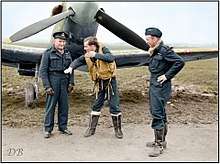Reg Grant
Reginald Joseph Cowan "Reg" Grant, DFC & Bar, DFM (3 June 1914 – 28 February 1944) was an officer of the Royal New Zealand Air Force and a flying ace of the Second World War. He commanded No. 485 Squadron RNZAF and later No. 65 Squadron RAF in operations over Europe, but was killed in a flying accident in 1944.[1][2]
Reg Grant | |
|---|---|
| Born | 3 June 1914 Woodville, New Zealand |
| Died | 28 February 1944 (aged 29) |
| Allegiance | New Zealand |
| Service/ | Royal New Zealand Air Force |
| Years of service | 1939–1944 |
| Rank | Wing Commander[1] |
| Unit | No. 145 Squadron RAF |
| Commands held | No. 65 Squadron RAF (1943–44) No. 485 Squadron RNZAF (1942–43) |
| Battles/wars | Second World War |
| Awards | Distinguished Flying Cross & Bar Distinguished Flying Medal |
Early life
Grant was born on 3 June 1914, in Woodville, a small town in New Zealand's North Island. He was educated at Auckland Grammar School. After schooling, he commenced working as a metal spinner. Grant joined the Royal New Zealand Air Force (RNZAF) in November 1939 and, having completed his flying training, he was posted to the United Kingdom as a sergeant pilot to join No. 145 Squadron at Tangmere in March 1941.[3]
Second World War
In June and July 1941, Grant was flying Spitfires from RAF Manston, and during that period he destroyed four Messerschmitt Bf 109s. By August 1941, and having taken part in 22 operations, Grant was awarded the Distinguished Flying Medal.[4] That same month he was promoted to the rank of pilot officer and posted to No. 485 Squadron, the all-New Zealand fighter unit.[3] In March 1942, Grant was promoted to flight lieutenant and the same month he destroyed a Focke-Wulf Fw 190 during a sweep from Cap Gris Nez to Dunkirk.[3] In May 1942, he took command of No. 485 Squadron and four months later was awarded the Distinguished Flying Cross (DFC) for setting an excellent example of leadership and efficiency.[5]

In November 1942, Grant's younger brother, Ian, was posted to No. 485 Squadron. On 13 February 1943, the squadron took off for a mission across northern France and shortly after crossing the French coast the Spitfires sighted and engaged a force of Fw 190s. However, a further 20 German fighters attacked out of the sun. Ian Grant was killed during the attack, one of three Spitfires to be shot down.[6] Reg Grant saw the threat but was unable to warn his brother in time. He immediately engaged the Fw 190 that had carried out the attack and shot it down.[7]
Grant completed his operational tour in March 1943, having carried out 150 sorties and destroying eight enemy aircraft. He was awarded a Bar to his DFC in June.[3] After some months in Canada, where he lectured New Zealand air crew trainees, Grant returned to England in November 1943 and was given command of No. 65 Squadron. Early in 1944 he was appointed wing commander (flying) of No. 122 Wing, equipped with Mustangs.[2] On 28 February 1944, Grant took off for a sortie across the English Channel. Shortly after take off, in cloud, the engine of his fighter cut out. After ordering the wing to carry on without him, he turned back to base. On coming out of cloud at 1000 feet, he bailed out but was too low for his parachute to open properly and fell to his death.[3] The crash site is located on the eastbound A13 carriageway approximately 100 metres east of the A128 flyover above the main A13 London to Southend Road.[7] Grant was buried at Brookwood Military Cemetery.[1]
Legacy
On 28 February 2004, 60 years to the day after Grant's death, a dedication of memorial and service was held for his remembrance.[8] In September 2010, a room naming and unveiling ceremony was held at HQ No. 485 Wing at Whenuapai, outside Auckland, in honour of three former Second World War Commanding Officers of No. 485 Squadron, one being Grant.[9]
References
- Grant, Reginald Joseph Cowan. Commonwealth War Graves Commission. Retrieved 2010-05-18
- Jack Rae. Thameside Aviation Museum. Retrieved 2011-05-18.
- Wing Commander Reginald Joseph Cowan Grant Archived 2010-05-25 at the Wayback Machine. New Zealand Fighter Pilots Museum. Retrieved 2011-05-18.
- D.F.M. for New Zealander. Evening Post, Volume CXXXII, Issue 35, 9 August 1941, Page 8. Retrieved 2011-05-18.
- "No. 35721". The London Gazette (Supplement). 7 August 1942. p. 4216.
- 485 (NZ) Squadron R.A.F. Retrieved 2011-05-18.
- Wing Commander Reginald Joseph Cowan Grant. Thameside Aviation Museum. Retrieved 2011-05-18.
- Wing Commander RJC Grant. Thameside Aviation Museum. Retrieved 2011-05-18.
- Link to History with Room Naming. Royal New Zealand Air Force. Retrieved 2011-05-18.
Further reading
- Martyn, Errol W. (1999). For Your Tomorrow: Fates 1943–1998. Published by Volplane Press, Christchurch, N.Z. OCLC 48077314. ISBN 978-0-473-06310-8.
- Thomas, Andrew (2010). RAF Mustang and Thunderbolt Aces. Published by Osprey Publishing, OCLC 429022115. ISBN 978-1-84603-979-9.